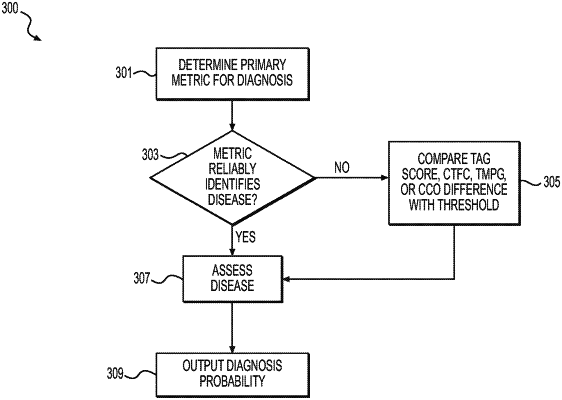| CPC G16H 50/30 (2018.01) [A61B 5/02007 (2013.01); A61B 5/026 (2013.01); A61B 5/7275 (2013.01); A61B 6/481 (2013.01); A61B 6/503 (2013.01); A61B 6/504 (2013.01); A61B 6/507 (2013.01); G06T 19/20 (2013.01); G16H 10/60 (2018.01); G16H 50/50 (2018.01); G16Z 99/00 (2019.02); A61B 6/5217 (2013.01); G06T 19/006 (2013.01); G06T 2207/30048 (2013.01); G06T 2207/30104 (2013.01); G06T 2210/41 (2013.01); G06V 20/20 (2022.01)] | 17 Claims |

|
1. A computer-implemented method of determining blood flow metrics, the method comprising:
receiving image data of a patient's vasculature;
identifying, from the image data, one or more voxels and/or pixels associated with the patient's vasculature and identifying a region of interest of the image data;
generating, based on the identified voxels and/or pixels and the region of interest, a patient-specific geometric model comprising a reconstruction of a patient's vasculature;
determining a patient-specific computational model of blood flow using the patient-specific geometric model obtained from the received image data, the patient-specific computational model of blood flow being different from the patient-specific geometric model;
determining at least one simulated patient-specific blood flow metric based on the patient-specific computational model of blood flow and the patient-specific geometric model, wherein determining at least one simulated patient-specific blood flow metric comprises discretizing the patient's vasculature of interest into finite elements based on 1) measured aortic pressure at an aortic inlet of the computational model and 2) calculated coronary resistances;
determining whether the simulated patient-specific blood flow metric is within a range between a non-functionally-significant blood flow metric value and a functionally significant blood flow metric value;
modeling, based on the patient-specific computational model of blood flow in the patient-specific geometric model and at least one of patient temperature and/or patient rheological properties of blood, a diffusivity of one or more virtual contrast agents in blood at a plurality of predetermined points in the patient-specific geometric model;
upon determining the simulated patient-specific blood flow metric is within a range between a non-functionally-significant blood flow metric value and a functionally significant blood flow metric value, determining one or more software simulated transluminal attenuation gradient (TAG) metrics, based on the diffusivity of the one or more simulated virtual contrast agents in blood in the patient-specific geometric, wherein determining one or more software simulated transluminal attenuation gradient (TAG) metrics comprises: assigning a known value of virtual contrast concentration near a source location and assigning values of virtual contrast concentration along lesions of the patient's vasculature, calculating transluminal gradients using a linear regression of the virtual contrast concentration along the lesions of the patient's vasculature, and applying a scaling factor to the virtual concentration gradient to determine a TAG metric score;
providing the simulated TAG metrics and the simulated patient-specific blood flow metric for output, and
determining a risk of heart disease for a patient using the determined TAG metric score and a threshold TAG score, the threshold TAG score being calculated based on a database of patients with measured blood flow metrics.
|